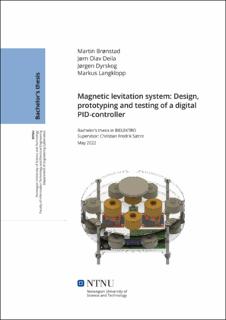| dc.contributor.advisor | Sætre, Christian Fredrik | |
| dc.contributor.author | Brønstad, Martin | |
| dc.contributor.author | Deila, Jørn Olav | |
| dc.contributor.author | Dyrskog, Jørgen | |
| dc.contributor.author | Langklopp, Markus | |
| dc.date.accessioned | 2022-07-02T17:21:54Z | |
| dc.date.available | 2022-07-02T17:21:54Z | |
| dc.date.issued | 2022 | |
| dc.identifier | no.ntnu:inspera:111566785:58950646 | |
| dc.identifier.uri | https://hdl.handle.net/11250/3002444 | |
| dc.description.abstract | Denne bacheloroppgaven handler om design, utvikling og bygging av en magnetisk levitasjonsplattform samt posisjonsregulering av en leviterende magnet ved hjelp av en digital PID-regulator.
For å oppnå dette har en matematisk modell blitt utviklet for å beskrive systemet. Modellen er basert på en eksisterende modell av et ekvivalent analogt system som har blitt utvidet til å beskrive det nye, digitale systemet. For å tilpasse den nye modellen måtte de nye komponentene modelleres. Modellen har også blitt implementert i Matlab og har blitt brukt til å simulere systemet. Dette inkluderer analyse av stabilitet og likevektspunkt, RGA- og kondisjonstallanalyse, linearisering og simulering av et PID-regulert system.
Modellen og simuleringene ligger til grunn for designet og byggingen av den nye magnetiske levitasjonsplattformen. Systemet ble designet med tanke på at det skulle være modulært, hvor forskjellige magnetkonfigurasjoner enkelt kunne testes ut. Designprosessen innebar design og kutting av modulære pleksiglassplater samt design og oppkobling av en elektrisk krets.
Implementeringen av den digitale PID-regulatoren ble gjort på en Teensy mikrokontroller. Reguleringssystemet ble designet som et 3x3 MIMO-system med tre PID-regulatorer i parallell. Posisjonen til den svevende magneten blir målt ved bruk av hall-effekt-sensorer.
Når et funksjonelt system var bygget ble det forsøkt stabilisert ved å justere inn PID-regulatoren. Dessverre ble systemet aldri stabilt, og regulatoren klarte ikke holde den svevende magneten i lufta i mer enn 20 sekunder på det meste. Etter mye analyse og diskusjon av det nåværende systemet er konklusjonen at det er mange grunner til at systemet ikke ble stabilt, blant annet det permanente magnetfeltet, elektromagnetene, støyfiltreringen samt tids- og budsjettrestriksjoner. | |
| dc.description.abstract | This bachelor's thesis documents the process of designing, prototyping and building a magnetic levitation platform and controlling the position of a levitating magnet with a digital PID controller.
To achieve this a mathematical framework was developed to describe the system. This framework was based on an existing model of an equivalent analog system, but was expanded to fit the current digital configuration by modelling the new components. The mathematical model was implemented in Matlab and used to simulate the system. This includes analysis of the stability and equilibrium, RGA and condition number analysis, linearization and simulation of a PID-controlled system.
The model and simulations laid the foundation for the design and building of the magnetic levitation platform from scratch. The system was designed with a focus on it being modular and to facilitate various configurations. The process involved designing and cutting modular plexiglass platforms as well as design and construction of an electrical circuit.
Implementation of a digital PID controller was done using a Teensy microcontroller. The control system was designed as a 3x3 MIMO system with three parallel PID controllers. The position of the levitating magnet is measured using hall-effect sensors
When a functional system was built, it was attempted to stabilize the system by tuning the PID controller. In the end the system did not stabilize as anticipated. At best the magnet levitated for no more than 20 seconds before becoming unstable. There has been done a lot of analysis and discussion regarding improvements on the current system. The conclusion is that it is unstable for a number of different reasons, which include the permanent magnetic field, the solenoids themselves, the noise filtering as well as time and budget constraints. | |
| dc.language | eng | |
| dc.publisher | NTNU | |
| dc.title | Magnetic levitation system: Design, prototyping and testing of a digital PID-controller | |
| dc.type | Bachelor thesis | |
